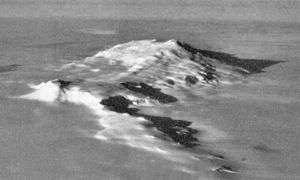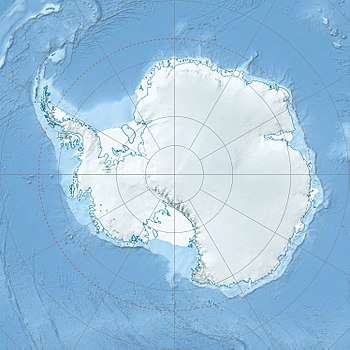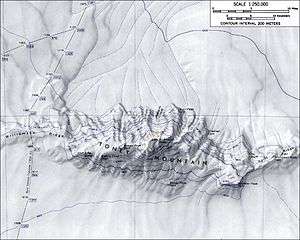Toney Mountain
Toney Mountain is an elongated snow-covered shield volcano, 60 km (38 mi) long and rising to 3,595 m in Richmond Peak, located 56 km (35 mi) SW of Kohler Range in Marie Byrd Land, Antarctica.[3]
| Toney Mountain | |
|---|---|
| Richmond Peak | |
 Aerial view of Toney Mountain from the east. | |
| Highest point | |
| Elevation | 3,595 m (11,795 ft) [1] |
| Prominence | 1,946 m (6,385 ft) [1] |
| Listing | Ultra |
| Coordinates | 75°48′S 115°49′W [1] |
| Geography | |
 Toney Mountain Antarctica | |
| Location | Marie Byrd Land, Antarctica |
| Geology | |
| Age of rock | Pleistocene to Holocene[2] |
| Mountain type | Shield volcano |
| Volcanic field | Marie Byrd Land Volcanic Province |
| Last eruption | Unknown |
Toney Mountain is an elongated volcanic massif that rises from a basaltic plateau.[4] A 3 km-wide summit caldera tops the volcano,[2] and is elongated in east-west direction; this orientation is shared with calderas on other volcanoes in Marie Byrd Land and reflects regional tectonic stress. The slopes of the volcano feature parasitic vents[5] and glacial corries,[6] and are much steeper north of the volcano than south of it. Most of the mountain is covered by ice and its eastern sector may be a crater.[7] That the mountain is mostly ice covered makes it difficult to determine its composition, the origin of the elongated shape of the volcano and the volcanological relation between the parasitic cinder cones and the main volcanic pile. Its volume may be about 2,800 cubic kilometres (670 cu mi).[4]
The plateau and parasitic cones are formed by hawaiite and the few outcrops on the main volcano by benmoreite and comendite. They contain phenocrysts of olivine, plagioclase, pyroxene and titanaugite in the former and of clinopyroxene, feldspar and olivine.[4]
An age of 9.1 million years ago has been obtained on a basaltic lava flow beneath the volcano,[6] and it has been inferred that the basal plateau formed between 10.1 and 9.1 million years ago. The massif is younger, with ages ranging from 1 million years in its lower parts[4] to 500,000 years ago. Holocene eruptions may have also occurred at Toney Mountain as indicated by 30 kyr ash layers in ice cores from Byrd Station,[2] although Mount Takahe and Mount Waesche are also candidates.[4] During that time period, a number of volcanic eruptions occurred in Antarctica as recorded by ash layers in ice; this coincides with the coldest period of the Wisconsin glaciation and it is possible that the effects of ash clouds from the Antarctic eruptions caused this period of cold global temperatures.[8] On the other hand, it is also possible that growing ice sheets during this period compressed magma chambers and thus triggered explosive eruptions.[9]
Toney Mountain lies in Marie Byrd Land, a tectonically and volcanically active region of Antarctica. There, a layer of basaltic rocks up to 5 kilometres (3.1 mi) thick underlie a series of felsic volcanic edifices. These basaltic rocks in turn are emplaced above a Paleozoic basement with granite intrusions of Devonian-Cretaceous, which crops out in some mountain ranges.[10] Beneath Toney Mountain, the basaltic floor rises from an elevation of 3 kilometres (1.9 mi) beneath sea level, and the volcano is situated on the floor of a graben. The region is further characterized by a 500 by 1,200 kilometres (310 mi × 750 mi) large dome-like uplift, part of the West Antarctic Rift System,[11] and it may reflect the presence of a stationary hotspot.[4]
Toney Mountain was probably among those viewed from a distance by Admiral Byrd and others of the USAS in plane flights from the ship Bear in February 1940. It was mapped in December 1957 by the oversnow traverse party from Byrd Station to the Sentinel Range, 1957–58, led by C.R. Bentley who proposed the name. Named after George R. Toney, scientific leader at Byrd Station in 1957, a participant in several Antarctic and Arctic operations, serving in both field and administrative capacities.[3]

References
- "Antarctica Ultra-Prominences" Listed as "Richmond Peak (Toney Mtn.)". Peaklist.org. Retrieved 2012-09-06.
- "Toney Mountain". Global Volcanism Program. Smithsonian Institution.
-

- LeMasurier, W.e. (1990). "B. Marie Byrd Land". Volcanoes of the Antarctic Plate and Southern Oceans. Antarctic Research Series. 48. pp. 146–255. doi:10.1029/ar048p0146. ISBN 978-0-87590-172-5.
- Paulsen, Timothy S.; Wilson, Terry J. (1 March 2010). "Evolution of Neogene volcanism and stress patterns in the glaciated West Antarctic Rift, Marie Byrd Land, Antarctica". Journal of the Geological Society. 167 (2): 401–416. Bibcode:2010JGSoc.167..401P. doi:10.1144/0016-76492009-044. ISSN 0016-7649.
- Andrews, J. T.; LeMasurier, W. E. (1 February 1973). "Rates of Quaternary Glacial Erosion and Corrie Formation, Marie Byrd Land, Antarctica". Geology. 1 (2): 75. Bibcode:1973Geo.....1...75A. doi:10.1130/0091-7613(1973)1<75:ROQGEA>2.0.CO;2. ISSN 0091-7613.
- DOUMANI, GEORGE A; EHLERS, ERNEST G (1 July 1962). "Petrography of Rocks from Mountains in Marie Byrd Land, West Antarctica". GSA Bulletin. 73 (7): 877. Bibcode:1962GSAB...73..877D. doi:10.1130/0016-7606(1962)73[877:PORFMI]2.0.CO;2. ISSN 0016-7606.
- Gow, Anthony J.; Williamson, Terrence (December 1971). "Volcanic ash in the Antarctic ice sheet and its possible climatic implications". Earth and Planetary Science Letters. 13 (1): 210–218. Bibcode:1971E&PSL..13..210G. doi:10.1016/0012-821X(71)90126-9. ISSN 0012-821X.
- Kyle, Philip R.; Jezek, Peter A.; Mosley-Thompson, Ellen; Thompson, Lonnie G. (August 1981). "Tephra layers in the Byrd Station ice core and the Dome C ice core, Antarctica and their climatic importance". Journal of Volcanology and Geothermal Research. 11 (1): 29–39. Bibcode:1981JVGR...11...29K. doi:10.1016/0377-0273(81)90073-1. ISSN 0377-0273.
- LeMasurier, W. E.; Rex, D. C. (10 June 1989). "Evolution of linear volcanic ranges in Marie Byrd Land, West Antarctica". Journal of Geophysical Research: Solid Earth. 94 (B6): 7223–7236. Bibcode:1989JGR....94.7223L. doi:10.1029/JB094iB06p07223. ISSN 2156-2202.
- LeMasurier, Wesley E. (2006). What Supports the Marie Byrd Land Dome? An Evaluation of Potential Uplift Mechanisms in a Continental Rift System. Antarctica. pp. 299–302. doi:10.1007/3-540-32934-x_37. ISBN 978-3-540-30673-3.
- LeMasurier, W. E.; Thomson, J. W., eds. (1990). Volcanoes of the Antarctic Plate and Southern Oceans. American Geophysical Union. p. 512 pp. ISBN 978-0-87590-172-5.